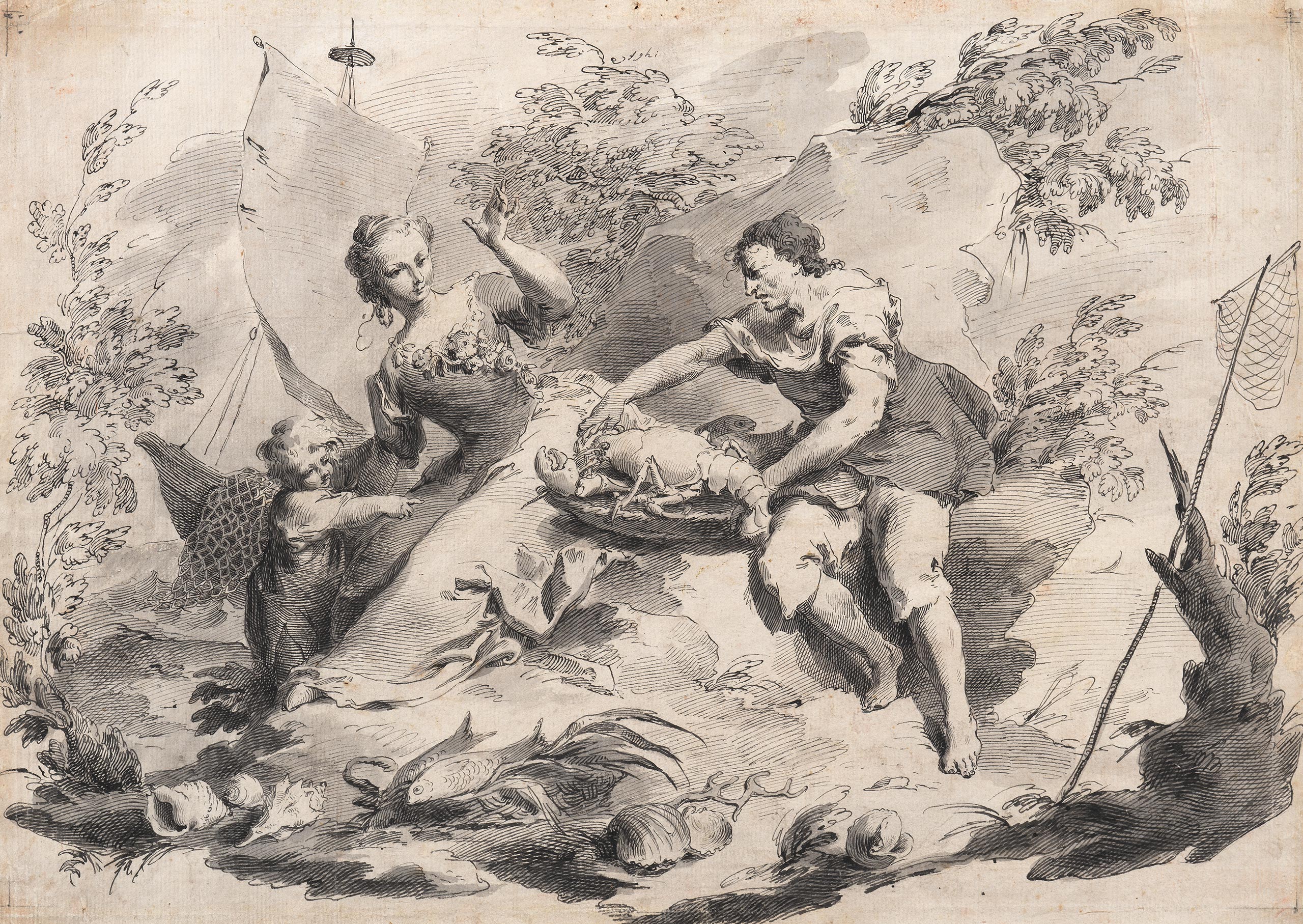
Novelli
Pietro Antonio
Venice 1729 — 1804
A Fisherman giving a Lobster and Fish
to a Young Woman with a Child
Pen, blanck ink, grey wash. The verso reddened for transfer.
Inscribed estghi ? upper center. Numbered 215 with pencil in a cartouche on the verso.
375 x 525 mm (14 12/16 x 20 11/16 in.)
This spectacular, large-scale, hitherto unpublished drawing can be unquestionably attributed to Pietro Antonio Novelli, a Venetian artist who is often mistaken for his namesake, the 17th-century Sicilian painter Pietro Novelli. Born in Venice to a noble family from Treviso, but soon orphaned, Novelli was carefully raised by his tutor Don Pietro Antonio Toni da Varana, who also bequeathed him a collection of drawings, prints and books. A cultivated young man, Novelli trained at the Academy of Venice, founded a few years earlier. In the late 1750s, when he was in his mid-thirties, he produced illustrations for a number of books, as well as paintings such as The Presentation in the Temple and The Virgin of Buonconsiglio, two canvases created for the church of San Francesco di Rovigo (1759). He was appointed professor at the Accademia di Venezia in 1768, with Drawing, Color and Invention, a reception piece of Bolognese- inspired classicism, but still imbued with a graceful rococo touch (now in the Accademia Galleries). Novelli executed several sets in and around Venice, in a light, luminous style combining the elegance of classicism with the gaiety of rococo.
In 1772, Catherine II of Russia commissioned him to paint The Family of Aeneas (Hermitage), to accompany Chiron delivering Achilles to Thetys by Pompeo Batoni. After several stays in Bologna, he was admitted to the Accademia Clementina, presided over by Vittorio Bigari. A trip to Rome in 1779 gave him a new sense of simplicity: his Last Supper for the Venetian convent of San Lazzaro degli Armeni won him the commission to decorate the ceiling of a room in Prince Marcantonio Borghese’s casino on the theme of Cupid and Psyche (1780-1781). In Rome, he was strongly supported by the Venetian milieu around Prince Abbondio Rezzonico and Ambassador Zulian, which included Giacomo Quarenghi, Antonio Canova, Francesco Piranesi and Giovanni Volpato, and the architect Gianantonio Selva.
It was with the latter that he collaborated, once back in Venice, to create the decors for numerous palaces between Padua and Venice, with a style that always falls between neo- classicism and late Baroque. Less at ease in the religious register, he nevertheless produced a number of noteworthy decors, such as the eight monochrome panels for the sacristy of Udine Cathedral, on the theme of the history of the patriarchate of Aquileia, in collaboration with the quadraturist Giuseppe Morelli (1792). The last major decorative cycle he designed, in 1794, was that of the Castello San Salvatore di Collalto, near Susegana, now destroyed and known only through photographs.
A prolific illustrator, Novelli produced numerous compositions and series intended for engraving, and played the game of emulation between engraving and drawing; some of his drawn compositions resemble engravings, with their meticulously hatched graphics and their use of grey, as is the case with our sheet. The destination of this large drawing remains uncertain. The back, reddened for the transfer, seems to indicate a possible transfer to engraving, but as the outlines are not incised, this project probably never materialized. Its size and curved composition could alternatively make it a project for the decoration of a Venetian palace. The gallant theme of the composition, reminiscent of the pastorals so characteristic of the rococo style, is here appropriately adapted to the marine world, a language typical of Venice. Seaweed, shellfish, fish and coral cover the floor as flowers. Instead of a galant shepherd, it is a fisherman who is offering a young woman the riches of the sea, shellfish, fish and seashells, in front of a boat whose prow and sail protrude from the back of the composition. The artist plays on contrasts and comparisons: the size of the lobster, almost as big as the child, the rusticity of the fisherman compared with the prettiness of the young woman, the fisherman’s net against the garland of flowers of the young woman underline the comical aspect of the scene, the incongruity of the offering.

